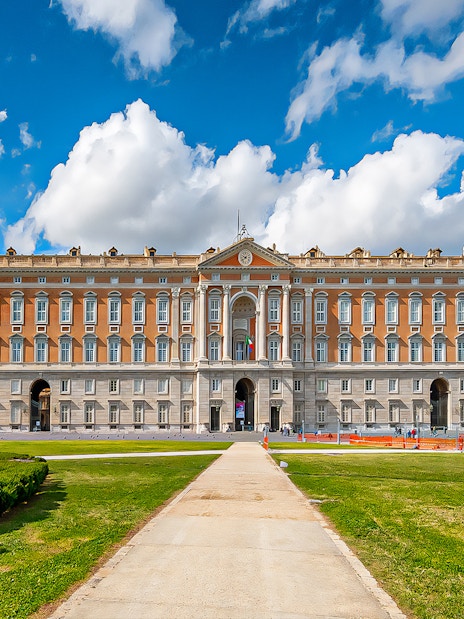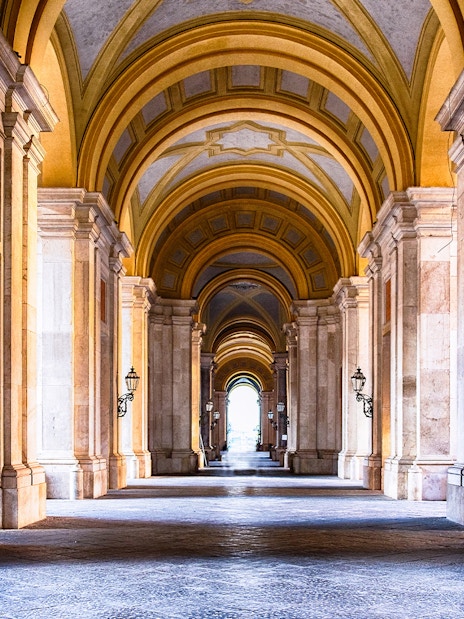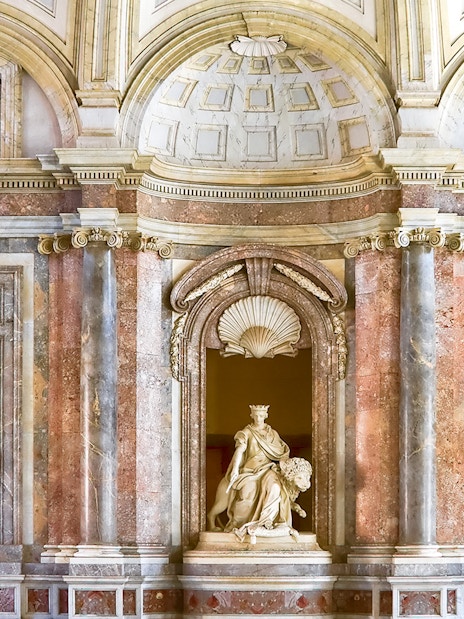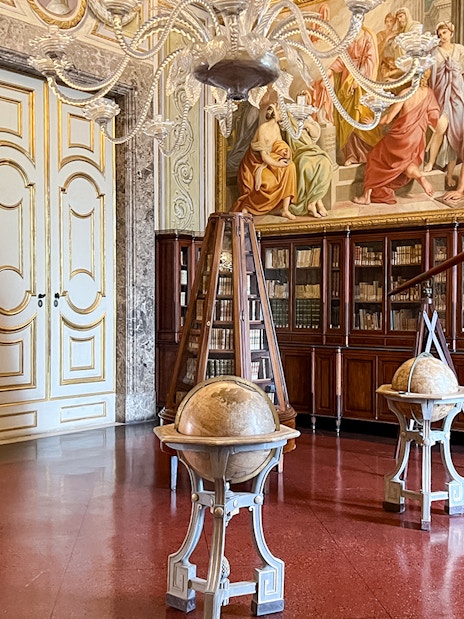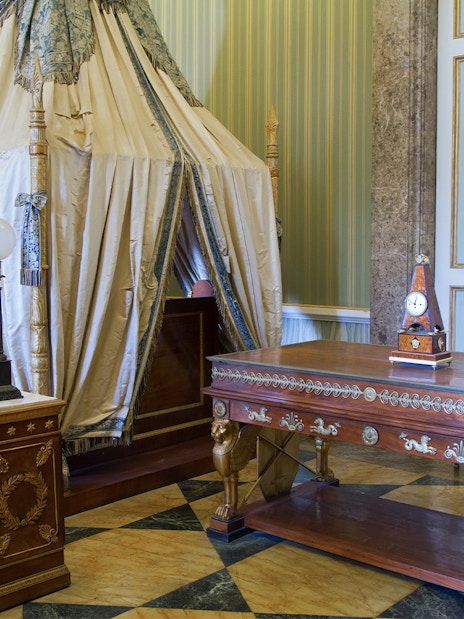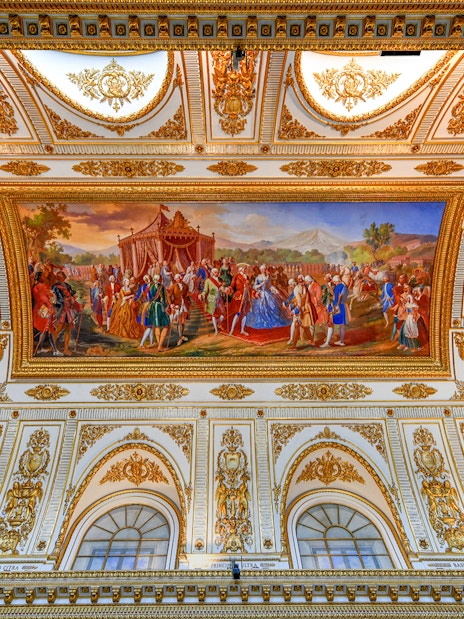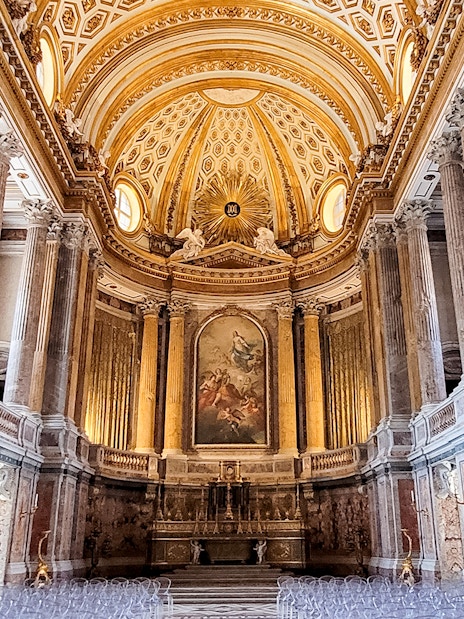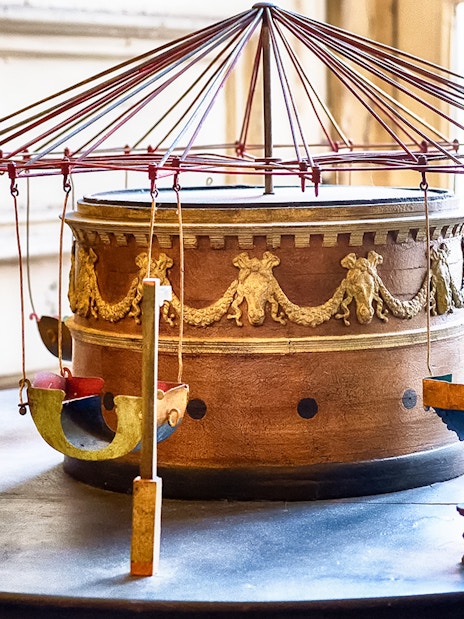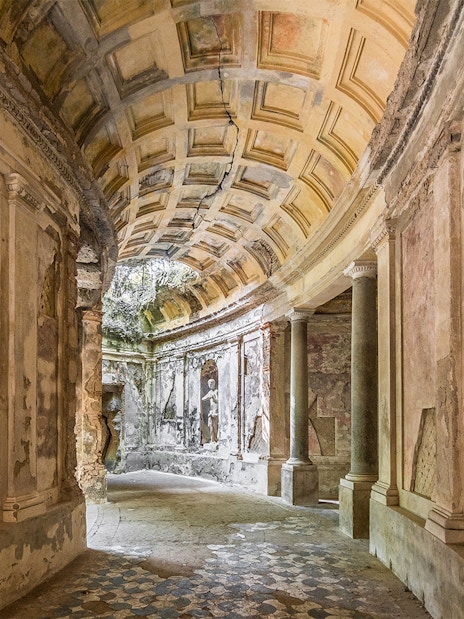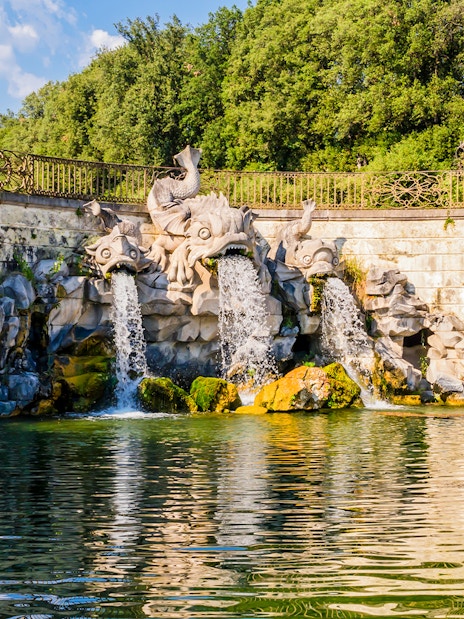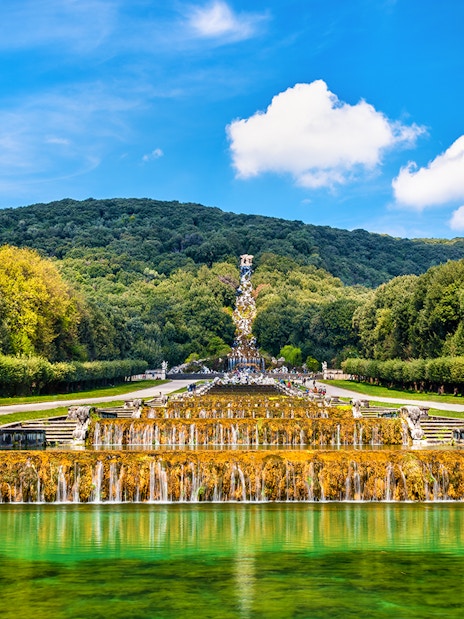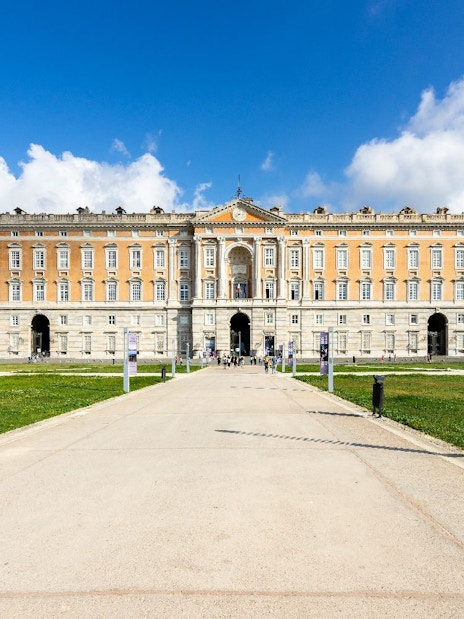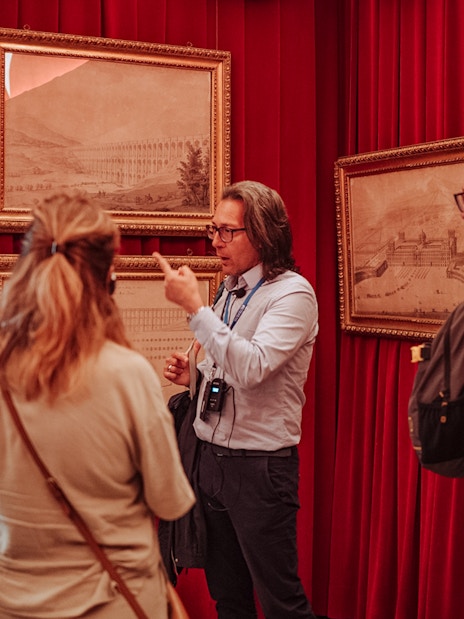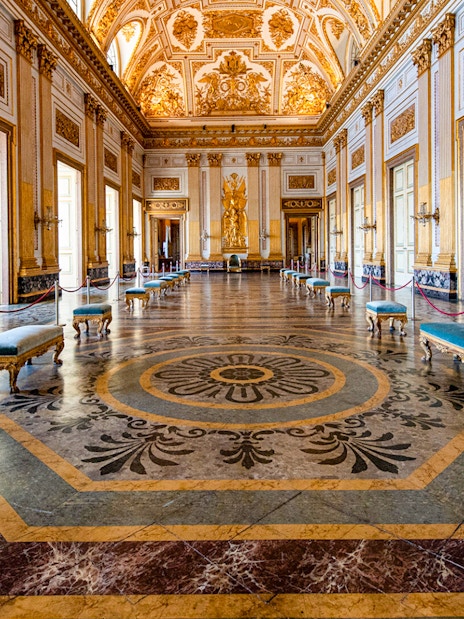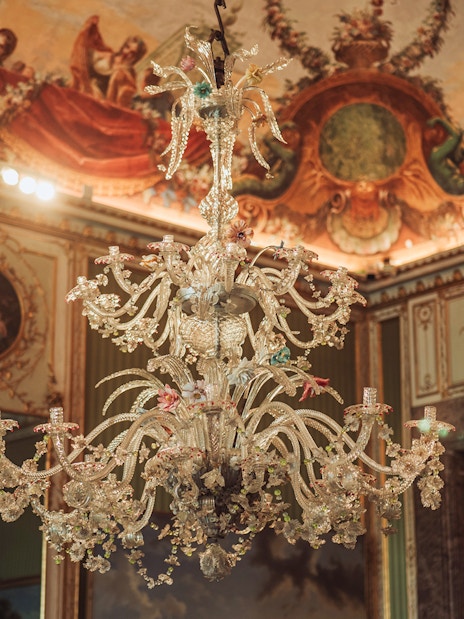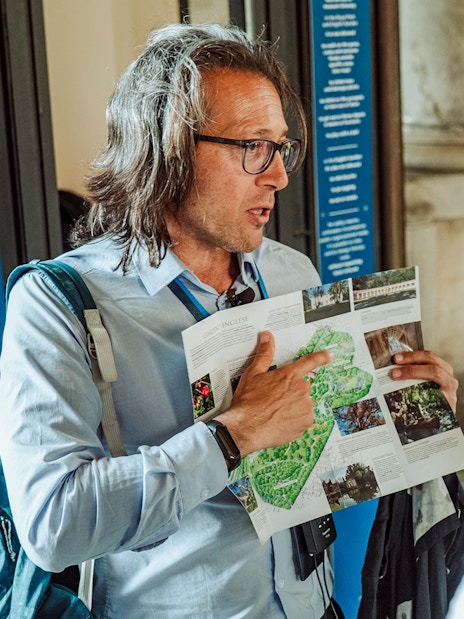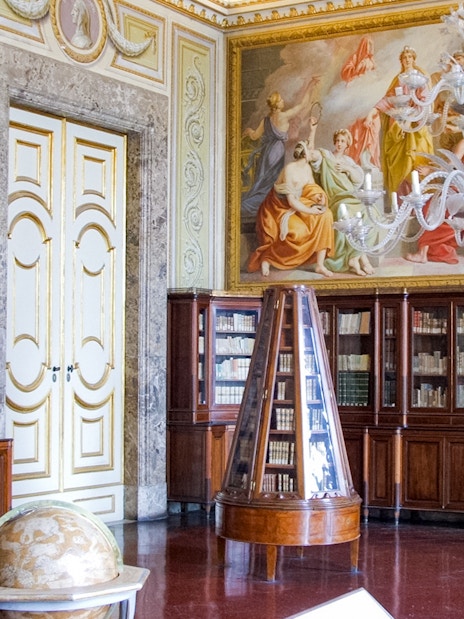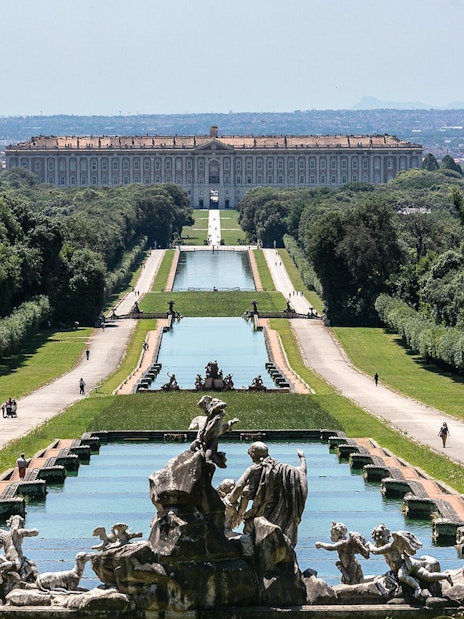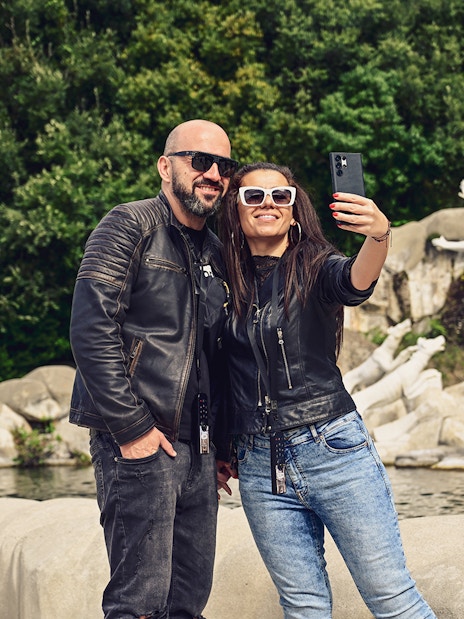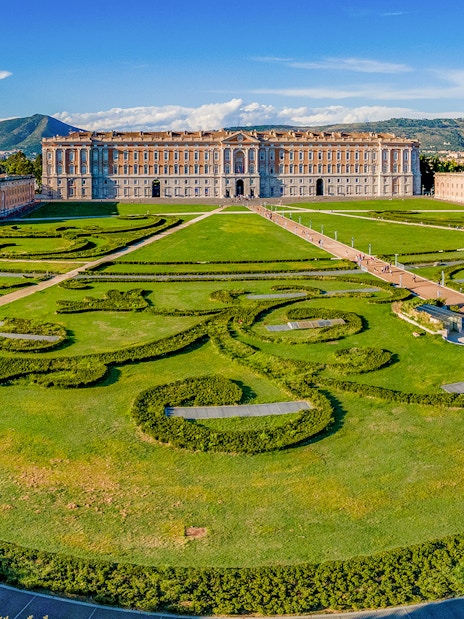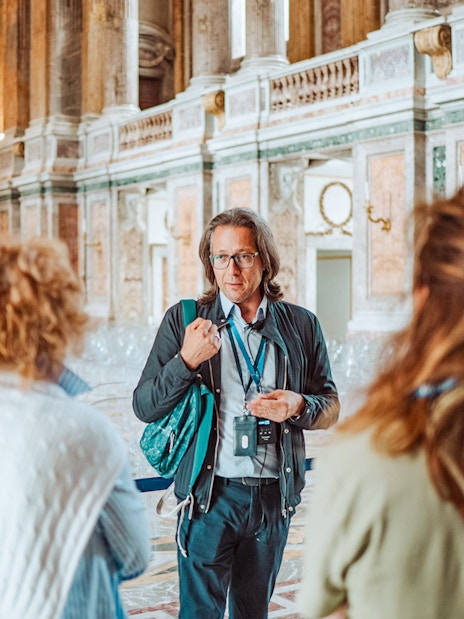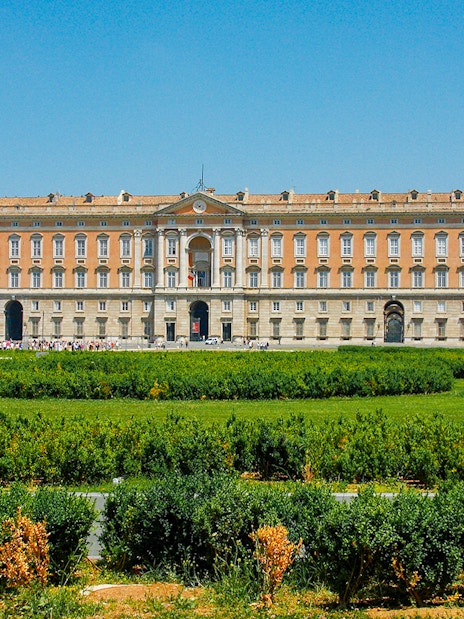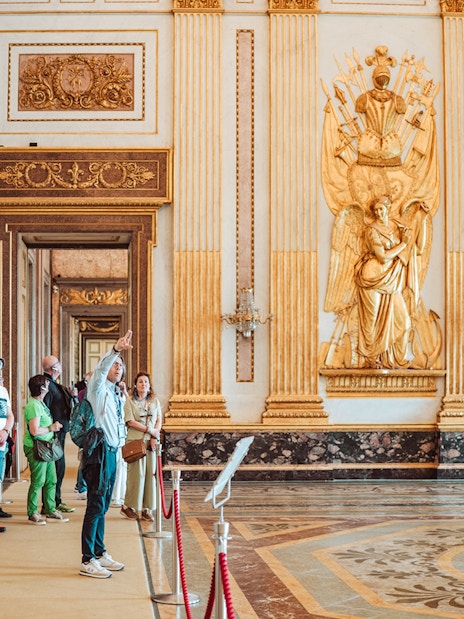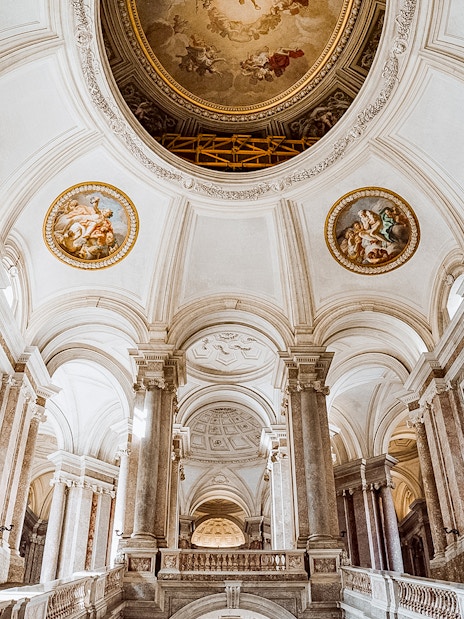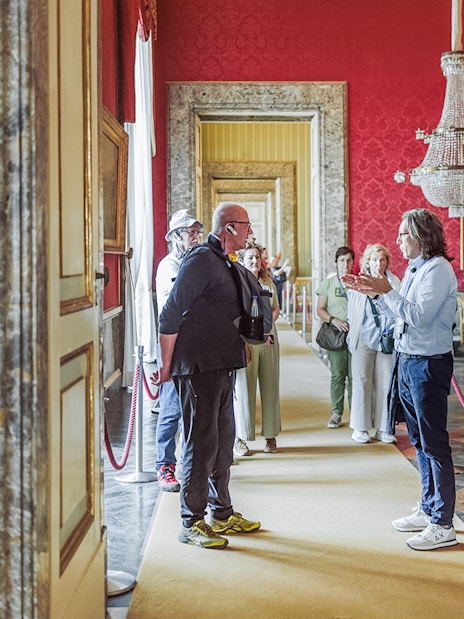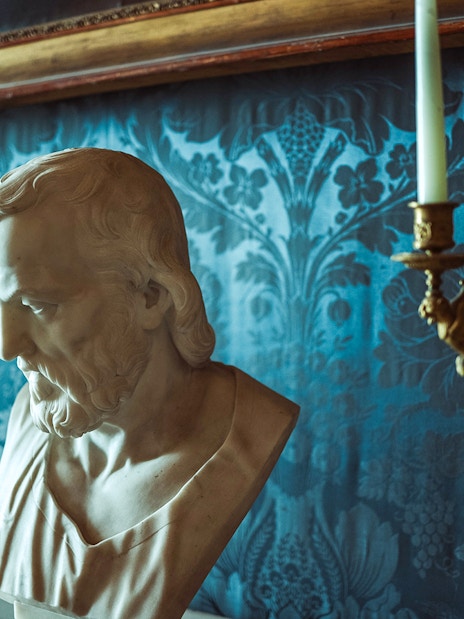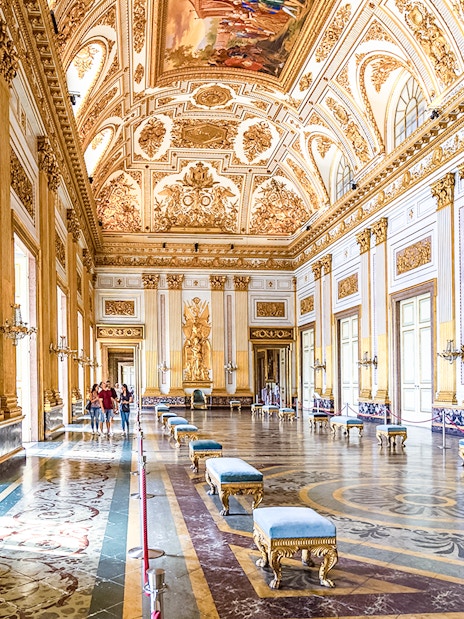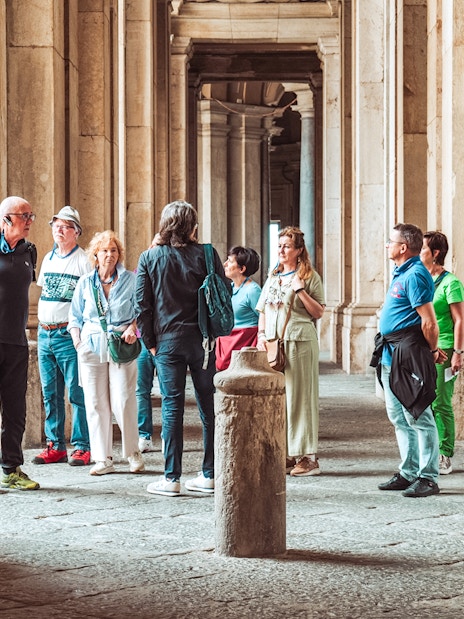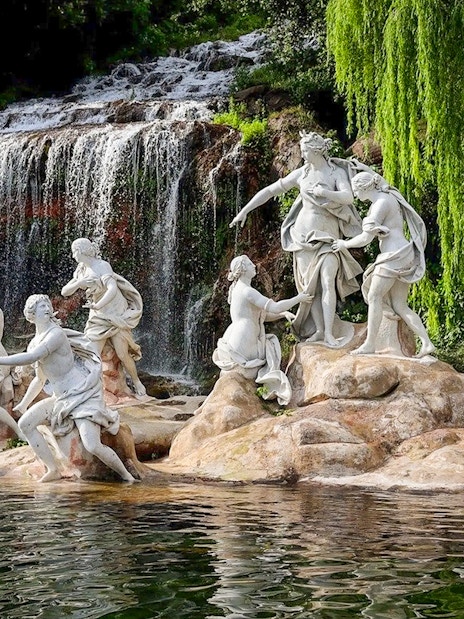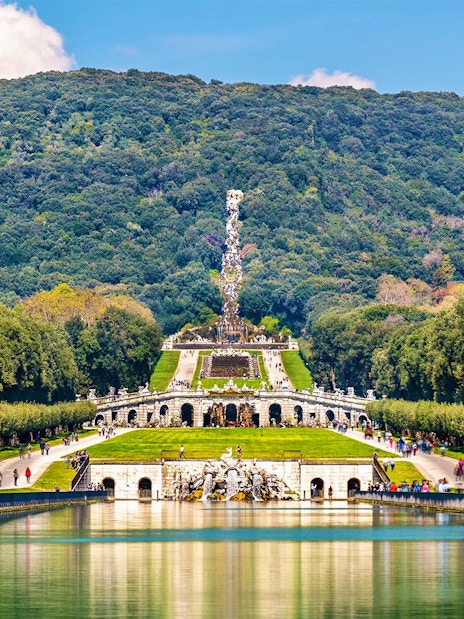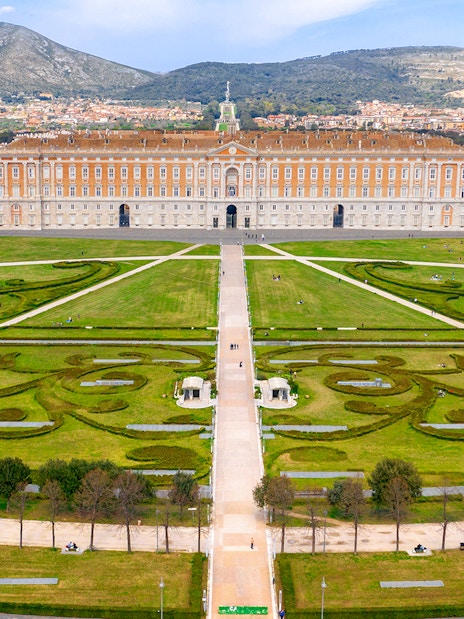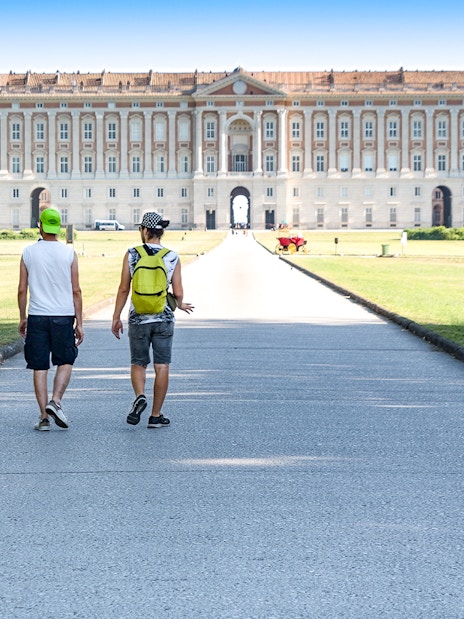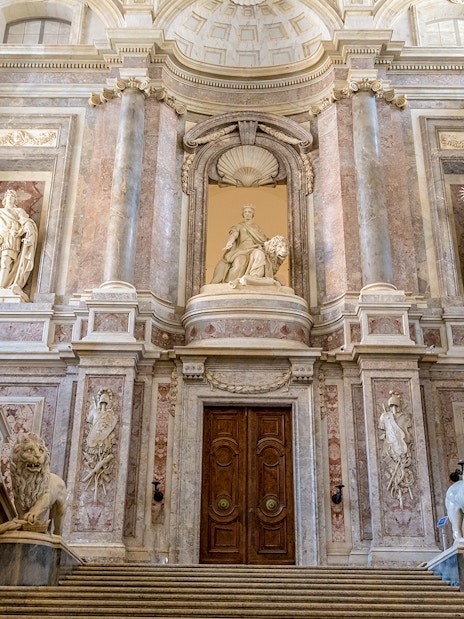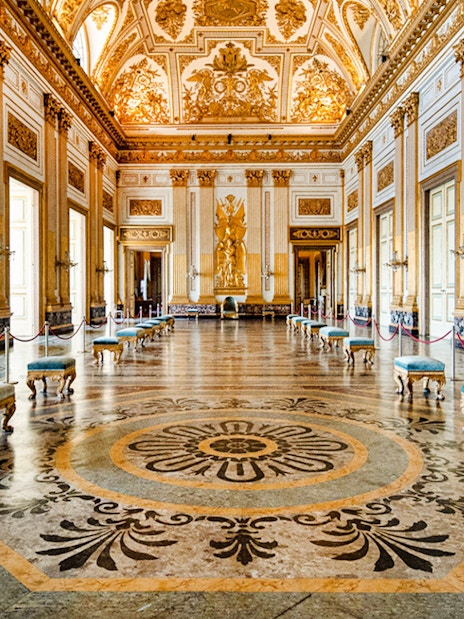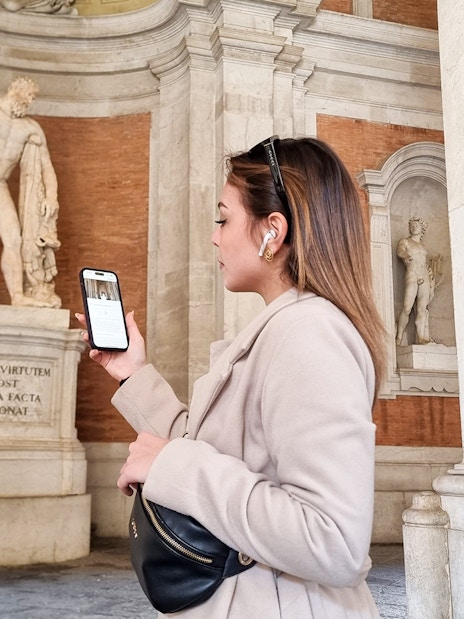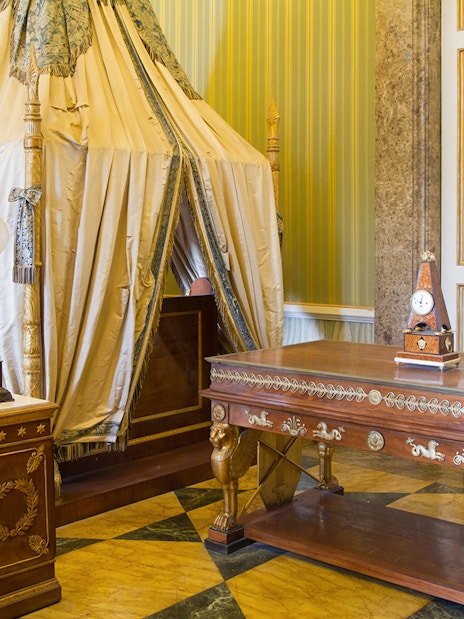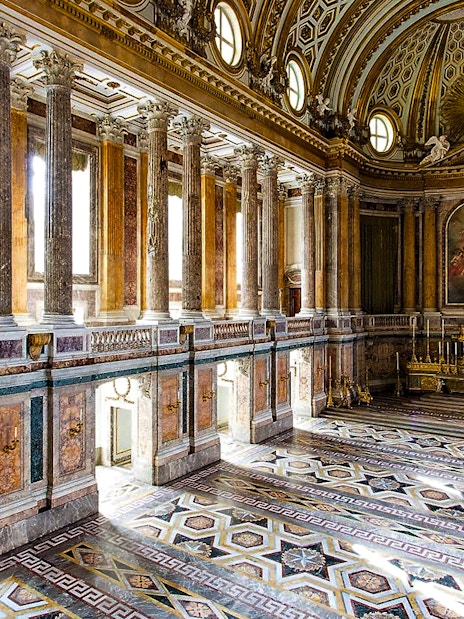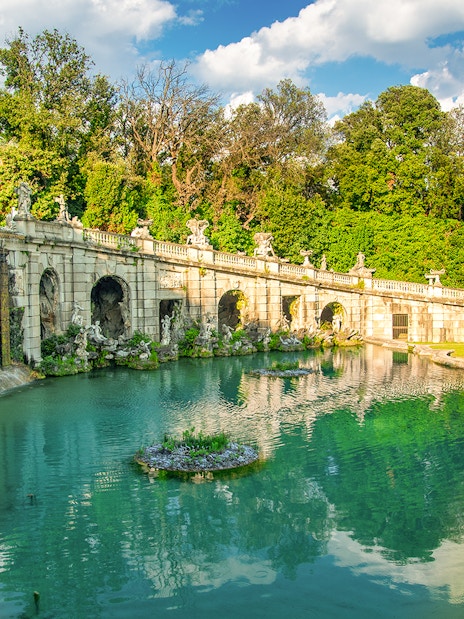Caserta Palace Gardens tickets

Affordable and flexible entry to both the Royal Park and Apartments.
- Enjoy the full royal experience with access to the grand Baroque-style Royal Apartments and the expansive Royal Park.
- Walk into the Baroque-style Royal Apartments, decked out with gilded ceilings, intricate frescoes, and larger-than-life chandeliers.
- Walk through the 120-hectare garden—a royal fairytale of cascading waterfalls, serene fountains, and lush landscapes.
- Elevate your visit with an optional audio guide in multiple languages for independent discovery.
Affordable and flexible entry to both the Royal Park and Apartments.
- Enjoy the full royal experience with access to the grand Baroque-style Royal Apartments and the expansive Royal Park.
- Walk into the Baroque-style Royal Apartments, decked out with gilded ceilings, intricate frescoes, and larger-than-life chandeliers.
- Walk through the 120-hectare garden—a royal fairytale of cascading waterfalls, serene fountains, and lush landscapes.
- Elevate your visit with an optional audio guide in multiple languages for independent discovery.
Inclusions
- Priority entry to the Royal Palace of Caserta
- Access to Royal Park
- Access to the Royal Apartments
- Audio guide in Italian, English, French, Spanish (as per option selected)
Exclusions
- Park activities (Bus tour, bicycle rental, quads, tandem, and horse-drawn carriage)
- Tip: Bring a picnic and enjoy the scenic royal gardens, especially during spring and summer when the park is in full bloom.
- The Royal Park and the Palace are wheelchair accessible with pathways, ramps and an elevator.
- Pets, dogs, strollers, bags, umbrellas, backpacks, other large items, or carriers are not allowed inside the Palace. However, there is a free checkroom service available at the entrance.
- The palace is closed on Tuesdays, New Year's Day (January 1), and Christmas Day (December 25).
- Going for the audio guide? Simply ensure that the guides are downloaded on the Headout app before your visit. It’s super simple to use, and you get offline access with an easy language-switching feature. Don't forget to carry your headphones with you!
- These tickets can't be cancelled or rescheduled.
Reviews
How do we collect reviews?
Snapshots from our guests
4.4
663 ratings
398
198
29
13
25
What our guests say
Donna
Jun 2025Verified booking
The inside of the Palace was beautiful. Especially the marble staircase and the theatre. It was a shame that the fountains were not on and many of the statues needed to be cleaned. It did look like it was a work in progress at some points in the gardens.
Carlo
May 2025Verified booking
Seeing and getting to know Matera live was a really interesting experience. From the TV reports or the various photographs shown here and there, one cannot at all grasp the beauty and uniqueness of the place, and then the story told by the guide helps you imagine the context and the hard life lived by the locals.
View original review in Italian
suellen
Apr 2025Verified booking
Quick and tailless. The palace is beautiful. I took the entrance from 8:45 a.m. and there was hardly anyone, then I left at about 12:30 p.m., and there was a world of people
View original review in Italian
Antoinette
Apr 2025Verified booking
Works of art by contemporary artists in the old state rooms of the Reggia: magnificent! A very special cultural experience!
View original review in German
Steven
Apr 2025Verified booking
Ease of ticket purchase and ease of entering the Palace
View original review in Italian
Roberto
Jun 2025Verified booking
Buying tickets great, too bad that the purchase ties you to an inflexible entrance time, so maybe better to wait in line and get in as soon as you have your ticket. Then the Reggia I already knew so I renewed the experience with awareness, I consider useless and misleading the exhibitions that are done inside by contemporary artists that have nothing to do with the context. Finally, the prices of the indoor refreshment bar are robbery, it is not good to take advantage of tourists like that. Two sandwiches and two 50 cl bottles of water 19 euros!
View original review in Italian
Elies
Jun 2025Verified booking
Wonderful staff, because of the strike they arranged my trip with Flixbus, so much the train as the bus leave you next door, in frente really said. I was in maybe 3 and a half hours with an aidioguide via app, a little errors there is still in the numeraire order, the bike I really liked at the end.
View original review in Italian
MATHIEU
Jun 2025Verified booking
On the website, no one says that the tickets arrive by e-mail much later after the order has been placed. On other applications, train/tourist tickets arrive a few minutes later. When you get your train tickets, you don't know whether you have to go to a ticket office in the station or board the train directly. The process of the day is not described. The description of the day's organization needs to be improved. If everything went well, too much stress due to lack of clear information. The castle visit was great!
View original review in French
Jenny
Jun 2025Verified booking
The audio tour was good but a map would've been good to follow too as we discovered we'd missed some of the palace that wasn't audio described.
Raffaella
Jun 2025Verified booking
the palace is very well maintained. nice day i did NOT like the fact that inside the historicity there were modern paintings on display. disappointed because the water because of the drought was closed and the fountains were turned off.delundant impact but i understand why
View original review in Italian
MERLAND
May 2025Verified booking
A very interesting visit, though, as the interior is far superior to the exterior. Rather cold and unpleasant reception Inaccurate interior signage Garden with beautiful views but no flowers, which makes it sad
View original review in French
Michela
May 2025Verified booking
The very knowledgeable guide thoroughly explained the site. Also interesting was the tour of the historical archive offered by the Royal Palace of Caserta, a small tour of the military settlements of German and then American troops during World War II
View original review in Italian
Stanciu
May 2025Verified booking
The palace is impressive from all points of view, size, conservation, art objects...the gardens also impressive but you need "piedi forti", it is enormous..we walked all the way up and came back by bus, for a fee. Justified, the money for the ticket.
This review is translated. Show original review.
MERI
May 2025Verified booking
The Palace and the whole complex is absolutely stunning!!! The "negative" notes are as follows: - there is no dedicated entrance for skip-the-line tickets, but on the other hand, despite the crowds the entrance was quite quick; - the audio guide provided with the tickets is not as comprehensive as the one provided by the Palace, it was very disappointing.
View original review in Italian
Giuseppe
May 2025Verified booking
We particularly appreciated the guide's preparation and competence and, last but not least, his friendliness, which never hurts.
View original review in Italian
Stefania
Apr 2025Verified booking
We were lucky because The tour guide who gave us the tour of the palace, was very knowledgeable and stimulated our curiosity, with simple explanations , making the tour very interesting !
View original review in Italian
maria
Apr 2025Verified booking
the guide, Serena Bertolino, was resoundingly detailed even with a wealth of anecdotes two pine hours without savings or hurry really prepared satisfied all the curiosities
View original review in Italian
Scala
Jun 2025Verified booking
Very good guide and very positive experience.
View original review in Italian
Poli
Jun 2025Verified booking
Place that deserves to be seen at least once in a lifetime, especially the throne room and the English garden.
View original review in Italian
Vittorio
Jun 2025Verified booking
It was not clear that the guide had the tickets. In the message it appeared " view tickets "
View original review in Italian
daniela
Jun 2025Verified booking
the guide was very good and well prepared. He conveyed his passion. the palace well cleaned and preserved. bravo!
View original review in Italian
MARCO
May 2025Verified booking
Excellent organization, serious and professional people
View original review in Italian
manuela
May 2025Verified booking
The efficiency of service and information
View original review in Italian
Villari
May 2025Verified booking
It was beautiful, thank you Pécari that people don't repeat deliveries
View original review in Italian
Elodie
May 2025Verified booking
The guide was very nice and knowledgeable
View original review in Italian
Learn all about the palace with uninterrupted access to a multilingual digital audio guide.
- Everything you get: Step into the Baroque-style Royal Apartments at your chosen time slot and marvel at their opulent interiors featuring gilded ceilings, intricate frescoes, and sparkling chandeliers. Take a stroll through the expansive Royal Park to relax amidst cascading waterfalls, serene fountains, and lush greenery.
- Why choose this: Unlike standard entry tickets, this one includes a digital audio guide in 4 languages for you to know more about the palace and enhance the experience of your visit.
Learn all about the palace with uninterrupted access to a multilingual digital audio guide.
- Everything you get: Step into the Baroque-style Royal Apartments at your chosen time slot and marvel at their opulent interiors featuring gilded ceilings, intricate frescoes, and sparkling chandeliers. Take a stroll through the expansive Royal Park to relax amidst cascading waterfalls, serene fountains, and lush greenery.
- Why choose this: Unlike standard entry tickets, this one includes a digital audio guide in 4 languages for you to know more about the palace and enhance the experience of your visit.
Inclusions
- Audio guide in Italian, English, French, Spanish
- Timed entry to the Royal Apartments
- Timed entry to the Royal Park
- Access to the English Gardens
Exclusions
- Meals
- Transportation
- The Palace is closed on Tuesdays, New Year’s (January 1), and Christmas (December 25).
- Download the audio guide on the Headout app before your visit for offline access and easy language switching.
- These tickets can't be cancelled or rescheduled.
Reviews
How do we collect reviews?
Snapshots from our guests
3.5
23 ratings
6
8
3
3
3
What our guests say
Anne
Jun 2025Verified booking
The Royal Palace of Caserta is truly a hidden gem. It exceeded our expectations at every turn. Entry into the grounds are strictly timed so visiting the Palace and apartments didn't feel crowded or rushed at all. It was a wonderful experience allowing us the opportunity to appreciate the magnificent Palace at our own pace. We took the option of a golf buggy ride around the gardens with a guide - it allowed us to visit a 10km circuit of the gardens easily with a highly knowledgeable guide who was also able to answer any questions. We highly recommend this option, we wouldn't have otherwise seen as much of the extensive grounds.
Galvani
May 2025Verified booking
Been fascinated by the beauty of the palace and its gardens and forests
View original review in Italian
serena
Jun 2025Verified booking
Davide
Jun 2025Verified booking
Denis
Jun 2025Verified booking
Anna
Jun 2025Verified booking
Miriam
Jun 2025Verified booking
Di
Jun 2025Verified booking
MARIA
Jun 2025Verified booking
John
Jun 2025Verified booking
LUCCAS
Jun 2025Verified booking
JEAN
May 2025Verified booking
Entraygues
May 2025Verified booking
Loredana
May 2025Verified booking
Tonino
May 2025Verified booking
Wolfgang
May 2025Verified booking
Santina
May 2025Verified booking
VALERIA
May 2025Verified booking
Laura
May 2025Verified booking
The cost of the ticket plus audioguide was much higher than the normal admission cost, and the audioguide on the cell phone is difficult to download on site due to poor connsections also inhibits use on the other functions of the phone.
View original review in Italian
Anabel
May 2025Verified booking
Explanations did not match the route
View original review in Spanish
serge
Jun 2025Verified booking
Skip lines and tour the grand halls of Royal Caserta with a historian.
- Bypass the long queues and dive straight into the palace's opulent halls. More time exploring, less time waiting!
- Listen closely as the expert guide divulges the fascinating secrets of the palace, which has often been compared to the Palace of Versailles.
- Step into the iconic rooms once used by nobles, including the majestic Throne Room, Court Theatre, and Palatine Library.
- End your tour with a walk through the lush royal gardens, filled with stunning fountains and vibrant blooms.
Skip lines and tour the grand halls of Royal Caserta with a historian.
- Bypass the long queues and dive straight into the palace's opulent halls. More time exploring, less time waiting!
- Listen closely as the expert guide divulges the fascinating secrets of the palace, which has often been compared to the Palace of Versailles.
- Step into the iconic rooms once used by nobles, including the majestic Throne Room, Court Theatre, and Palatine Library.
- End your tour with a walk through the lush royal gardens, filled with stunning fountains and vibrant blooms.
Inclusions
- 2-hour tour of Caserta Royal Palace Apartments
- English, Italian, or Spanish speaking guide
- Skip-the-line access to Royal Apartments and Royal Park
- Small groups of up to 20 people
- Headphones for a group more than 6 people
Exclusions
- Guided tour of Royal Park
- Transfers and meals
- Tip: The Throne Hall is full of allegories and symbols— make sure to ask your guide to point out the hidden meanings behind the lavish decorations.
- Even with skip-the-line access, plan to arrive 15-20 minutes early to ensure a smooth check-in, as the palace enforces strict entry timings.
- Note: The tour does not cover the Royal Park and English Gardens.
- While the Palace is accessible, due to the historic layout and the route that the tour follows, portions of the experience are not wheelchair-friendly.
- Some rooms may have photography restrictions, so check with your guide before taking pictures.
- Pets, dogs, strollers, bags, umbrellas, backpacks, other large items, or carriers are not allowed inside the Palace. However, there is a free checkroom service available at the entrance.
- The palace is closed on Tuesdays, New Year's Day (January 1), and Christmas Day (December 25).
- You can cancel these tickets up to 24 hours before the experience begins and get a full refund.
Reviews
How do we collect reviews?
Snapshots from our guests
4.7
153 ratings
117
31
3
1
1
What our guests say
Carlo
May 2025Verified booking
Seeing and getting to know Matera live was a really interesting experience. From the TV reports or the various photographs shown here and there, one cannot at all grasp the beauty and uniqueness of the place, and then the story told by the guide helps you imagine the context and the hard life lived by the locals.
View original review in Italian
Michela
May 2025Verified booking
The very knowledgeable guide thoroughly explained the site. Also interesting was the tour of the historical archive offered by the Royal Palace of Caserta, a small tour of the military settlements of German and then American troops during World War II
View original review in Italian
Giuseppe
May 2025Verified booking
We particularly appreciated the guide's preparation and competence and, last but not least, his friendliness, which never hurts.
View original review in Italian
maria
Apr 2025Verified booking
the guide, Serena Bertolino, was resoundingly detailed even with a wealth of anecdotes two pine hours without savings or hurry really prepared satisfied all the curiosities
View original review in Italian
Scala
Jun 2025Verified booking
Very good guide and very positive experience.
View original review in Italian
Vittorio
Jun 2025Verified booking
It was not clear that the guide had the tickets. In the message it appeared " view tickets "
View original review in Italian
daniela
Jun 2025Verified booking
the guide was very good and well prepared. He conveyed his passion. the palace well cleaned and preserved. bravo!
View original review in Italian
Elodie
May 2025Verified booking
The guide was very nice and knowledgeable
View original review in Italian
Nicolosi
Apr 2025Verified booking
VSIIAT PLEASANTNESS AND DRIVING ABILITY
View original review in Italian
Deiana
Apr 2025Verified booking
The chaperone Walter very good ... super professionalism ... very knowledgeable
View original review in Italian
Eleonora
Apr 2025Verified booking
A great guide for an unparalleled visit to the Palace. Thank you
View original review in Italian
Turcu
Mar 2025Verified booking
Very good guide very professional
View original review in Italian
Vincenza
Jun 2025Verified booking
Cinzia
Jun 2025Verified booking
Silvia
Jun 2025Verified booking
Maria
Jun 2025Verified booking
SERGIO
Jun 2025Verified booking
MARISA
Jun 2025Verified booking
Mara
Jun 2025Verified booking
Giovanni
Jun 2025Verified booking
Massimo
Jun 2025Verified booking
Chiara
May 2025Verified booking
Gheno
May 2025Verified booking
BRUNO
May 2025Verified booking
SHEKINA
May 2025Verified booking
Experience Caserta’s royal grandeur with an exclusive, art historian-led private tour.
- Skip lines and spend more time exploring the luxurious apartments, halls and court rooms of Bourbon dynasty.
- Get immersive insights into Bourbon history and palace evolution from a regional art history specialist.
- Ascend the monumental Staircase of Honor and explore opulent rooms decorated in rich stucco and frescoes.
- Finish with a peaceful walk through 120 hectares of Italian gardens, decorated with fountains, statues, and waterfalls.
Experience Caserta’s royal grandeur with an exclusive, art historian-led private tour.
- Skip lines and spend more time exploring the luxurious apartments, halls and court rooms of Bourbon dynasty.
- Get immersive insights into Bourbon history and palace evolution from a regional art history specialist.
- Ascend the monumental Staircase of Honor and explore opulent rooms decorated in rich stucco and frescoes.
- Finish with a peaceful walk through 120 hectares of Italian gardens, decorated with fountains, statues, and waterfalls.
Inclusions
- 2-hour private tour of the Royal Palace of Caserta
- Private groups of 1 to 10 people
- Skip-the-line access to the Royal Apartments and Royal Park
- Spanish, French, Italian, German or English-speaking guide (as per option selected)
- Audio headsets for groups larger than 7
Exclusions
- Guided tour of the Royal Park
- Tip: Set aside an hour to explore the Royal Park at your own pace. Your ticket includes access, and the guide’s insights will help you maximize this self-guided portion.
- While the private tour focuses on the palace interiors, your guide will provide detailed context about the iconic Royal Park, which you can explore independently after the tour.
- Even with skip-the-line access, plan to arrive 15-20 minutes early to ensure a smooth check-in, as the palace enforces strict entry timings.
- The tour can be made accessible for wheelchair users, but advance notice is required to ensure the best route is arranged.
- Pets, dogs, strollers, bags, umbrellas, backpacks, other large items, or carriers are not allowed inside the Palace. However, there is a free checkroom service available at the entrance.
- Some rooms may have photography restrictions, so check with your guide before taking pictures.
- The palace is closed on Tuesdays, New Year's Day (January 1), and Christmas Day (December 25).
- You can cancel these tickets up to 24 hours before the experience begins and get a full refund.
A royal day out! Hassle-free visit to the Royal Palace of Caserta with train tickets, priority access and an audio guide.
- Enjoy a smooth, stress-free journey with a round-trip train ticket from Naples—getting to the Royal Palace couldn’t be easier!
- Skip the lines with priority entry and head directly to the royal halls—no waiting required!
- Explore the beautiful Hall of Astrea, King's private chambers, Throne Room, and more at your own pace with a smart audio guide available on your phone.
- Conclude your visit with a delightful stroll through the Royal Park, adorned with cascading fountains and sculptures.
A royal day out! Hassle-free visit to the Royal Palace of Caserta with train tickets, priority access and an audio guide.
- Enjoy a smooth, stress-free journey with a round-trip train ticket from Naples—getting to the Royal Palace couldn’t be easier!
- Skip the lines with priority entry and head directly to the royal halls—no waiting required!
- Explore the beautiful Hall of Astrea, King's private chambers, Throne Room, and more at your own pace with a smart audio guide available on your phone.
- Conclude your visit with a delightful stroll through the Royal Park, adorned with cascading fountains and sculptures.
Inclusions
- Priority entry to Royal Palace Apartments and Park
- Round-trip train tickets from Naples to Caserta
- Audio guide in Italian, English, Spanish, French
Exclusions
- Guided tour
- Headphones
- Food and drinks
- Tip: Notice the ingenious double-revolution staircase at the Royal Palace, allowing the king to ascend and descend without meeting anyone on the stairs.
- The train from Naples to Caserta takes around 40 minutes, plus a 5-10 minute walk to the palace. Be sure to check the train schedule in advance to arrive on time, as this ticket has a specific entry window.
- Even with skip-the-line access, plan to arrive 15-20 minutes early to ensure a smooth check-in, as the palace enforces strict entry timings.
- Pets, dogs, strollers, bags, umbrellas, backpacks, other large items, or carriers are not allowed inside the Palace. However, there is a free checkroom service available at the entrance.
- Some rooms may have photography restrictions, so check with the staff before taking pictures.
- The Royal Park and the Palace are wheelchair accessible with pathways, ramps and an elevator.
- The palace is closed on Tuesdays, New Year's Day (January 1), and Christmas Day (December 25).
- These tickets can't be cancelled or rescheduled.
Royal Palace of Caserta Caserta Palace Gardens
Royal Palace of Caserta Gardens in a nutshell

- Size and scope: Area is 120 hectares (296 acres) and length is approximately 3.3 kilometers (2 miles)
- Water features: A breathtaking Grand Cascade, featuring multiple waterfalls, leads to a large reflecting pool. Dotted throughout the gardens are ornamental fountains, each a unique work of art with its own symbolic meaning.
- Botanical diversity: Thousands of plants, both native and exotic, were meticulously chosen to add color, texture, and fragrance to the gardens. The gardens also house a rich variety of trees, creating a sense of grandeur and providing shade.
- Design and layout:
- Formal Italian Gardens: Featuring meticulously designed parterres, sculptures, and geometric patterns, these gardens were inspired by the likes of Versailles.
- Romantic English Garden: Offering a contrasting landscape, this section boasts winding paths, lakes, and a more natural aesthetic.
- "Telescope Effect": The layout of the gardens uses a clever optical illusion, aligning pools, fountains, and cascades to create a seemingly endless vista from the palace.
Royal Palace of Gardens tickets explained
Entry tickets
Guided tours
Tickets with transfers
Park access
yes
Yes
Yes
Apartments access
Option to upgrade
Yes
Yes
Additional features
Optional audio guide in Italian, English, French, Spanish.
Italian/English speaking guide, small group, priority access, audio headsets, optional private tour (of the apartments).
Train ticket to Caserta from Napoli Central Station, audio guide, priority access.
Why buy?
Explore at your own pace without committing to the full palace, perfect for independent travelers and nature lovers.
Enrich your visit with insider knowledge and fascinating stories. Bypass crowds with priority entry.
Hassle-free journey, maximize time at the site, enjoy the ride without logistics stress.
Starting from
€15
€39
€44
Recommended tickets
Royal Palace of Caserta Park Tickets
Royal Palace of Caserta Small-Group Guided Tour
From Naples: Royal Palace of Caserta Tickets with Round-Trip Train and Audio Guide
A walk inside the Caserta Palace Gardens

The Parterre and the Old Woods
The Parterre is the wide clearing that you come across when you leave Reggia di Caserta's gallery. It follows the French Garden designs and you will find wide grasslands that resemble a grass carpet. The Old Woods, on the left of the Parterre, existed before the buildings and were kept to maintain the natural element of the garden. It was also the 'Secret Garden' used for entertainment and as a resting place for the court.

The Fountains
In the Caserta Palace Gardens, you will come across a long alley with artificial fountains and cascades that fill multiple basins along a canal. Each fountain is decorated with rich sculptures such as dolphins, Aeolus, Ceres, Venus, Adonis, and a lot more. The fountains were designed in a way that they appear to be much shorter than their actual length of 3 km, thanks to short waterfalls and large basins, creating an optical artifice.

The English Garden
Occupying an area of 24 hectares, The English Garden is the first example of an informal garden in Italy. The garden is home to rare and exotic plants that were imported from around the world. Apart from the plants, this garden also houses several lakes, temples, a greenhouse, an English mansion, a bee house, and many other beautiful statues and elements.

The Carolino Aqueduct
The Carolino Aqueduct, a 38km hydraulic engineering marvel, was built to supply water to the fountains, the Royal Palace of Caserta, the cities Caserta and Naples around the Palace, and all the farms in the area. The entire conduit is buried except for the bridge which is made up of several arches and turrets for improved stability and better maintenance.

The Complex of Saint Leucio Belvedere
Initiated by King Ferdinand IV, The Complex of Saint Leucio Belvedere is a huge village complex in the Royal Palace of Caserta. This complex comprises a functioning silk factory, a living silk museum, Former Royal Apartments and manicured gardens. It was also the birthplace of women’s rights at the request of Queen Maria Carolina.

San Silvestro’s Oasis
A 100 hectares estate bought by King Charles of Bourbon, San Silvestro's Oasis was once a place for hunting, hiking, and immersing oneself in nature. Today, the oasis is funded by the World Wide Fund for Nature where visitors can indulge in a lot of activities here such as night tours, learning about bats, seeing fireflies, nature trails, and more.
History of the Caserta Palace Gardens

The visionary beginnings
1752-1773
Designed by Luigi Vanvitelli, the works for Caserta Palace Gardens began in 1753 and combined the design of the Italian Renaissance Garden with a solution for the Versailles gardens. Luigi introduced the ‘Telescope Effect’ by designing a straight avenue that started from Naples and ended at the waterfall's top that was located at the end of the Garden of the Royal Palace of Caserta.

A period of slow progress
1773-1845
The current garden at the Royal Palace of Caserta is a reduced version of Luigi’s design. After Luigi passed away in 1773, work halted for almost 4 years. In 1777, his son Carlo presented the King with a reduced version of the original design because of economic difficulties at the time and the number of fountains in the second part of the Caserta Palace Gardens. However, Carlo made sure that his father’s vision was accomplished for the garden with the 3.3 km canal.

The Queen’s Rivalry
Queen Maria Carolina, the wife of King Ferdinand IV, was in competition with her sister Queen Marie Antoinette of France. She requested that an English Garden be built that obscured the beauty of Petit Trianon of Versailles. The construction began in 1786 and the Queen invested her personal fortunes to make sure that the English Garden was quite different from the Park at the Royal Palace of Caserta.
Fountains inside the Caserta Palace Gardens





See all photos
Frequently asked questions about Caserta Palace Gardens
What was the inspiration behind the gardens of Royal Palace of Caserta?
The Caserta Palace Gardens were heavily inspired by the French Baroque style, particularly the grandeur of the Palace of Versailles. Architect Luigi Vanvitelli aimed to create a sense of order, symmetry, and awe-inspiring vistas mirroring the power and wealth of the Bourbon dynasty.
What are the key features of the 'telescope effect' in the garden's design?
The "telescope effect" in the Caserta Palace Gardens is a clever optical trick achieved through strategic alignment and perspective. Pools, fountains, and cascades are positioned along a central axis, creating the illusion of an endless depth. Statues and sculptures frame this view, drawing the eye further down the line and enhancing the perception of vastness. It makes the gardens appear much larger and more expansive than they truly are.
How do the Italian gardens and English landscapes differ within the Caserta Palace Gardens?
The Italian gardens are characterized by their formal layout, symmetrical design, and ornate fountains. In contrast, the English landscapes feature more natural, romantic elements such as rolling lawns, winding paths, and varied plantings that mimic natural scenery, creating a relaxed and picturesque environment.
How has the design of the Caserta Palace Gardens influenced modern landscape architecture?
The Caserta Palace Gardens have influenced modern landscape architecture through their innovative use of space, water features, and the integration of formal and natural elements. The 'telescope effect' and the blending of Italian and English styles have inspired contemporary garden designers to create spaces that balance formality with natural beauty. Modern examples include the National Mall in Washington D.C. with its reflecting pool and monuments aligned along a central axis, or Longchamp Park in Paris, where the Grand Cascade leads the eye towards the cityscape.
What is the historical significance of the Caserta Palace Gardens in relation to the Bourbon dynasty?
The gardens symbolize the power and sophistication of the Bourbon dynasty. They were designed to showcase the wealth and taste of the Bourbons, serving as a symbol of their rule and cultural influence. The gardens also reflect the political and social aspirations of the dynasty during the 18th century.
How are the Caserta palace gardens maintained and preserved today?
To maintain their UNESCO World Heritage status, the Caserta Palace Gardens undergo a multi-faceted preservation effort. This includes meticulous restoration of fountains, sculptures, and water systems, alongside careful conservation of both completed Baroque sections and undeveloped areas. Horticultural experts meticulously care for the diverse plant collection, ensuring the gardens remain a flourishing testament to history and a captivating masterpiece of landscape design.
What are the best times of year to visit the Caserta Palace Gardens for optimal beauty?
The best times to visit are in the spring and early summer when the gardens are in full bloom, and the weather is pleasant. The fall season also offers beautiful foliage and a more serene experience. Each season, however, has its unique charm and beauty.
Are there any guided tours for the Gardens?
Yes, guided tours are available for the Caserta Palace Gardens. These tours offer in-depth insights into the garden's design, history, and key features, allowing visitors to fully appreciate the grandeur and intricacies of the gardens.

